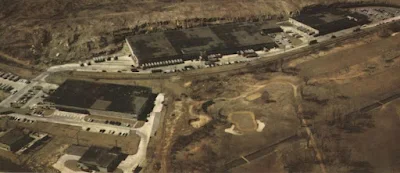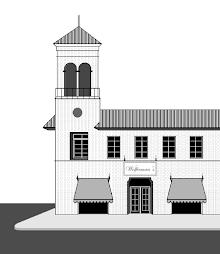The typical American supermarket of the 1940s was much smaller than the standard food store of later years. Case in point, the circa-1946 Safeway depicted here, which encompassed around 9,000 square feet.
Original drawing from Safeway Stores, Incorporated Annual Report 1946
Graphic from Safeway Stores, Incorporated
By the mid-1950s, the typical American supermarket -such as this Red Owl unit- covered approximately 18,000 square feet.
Drawing from Red Owl Stores, Incorporated Annual Report 1955
A & P's "A Blueprint for the Future," a store design from 1970. The prospective super mart encompassed 29,000 square feet. By the 1980s, a large grocery store might have spanned 40,000 square feet.
Graphic from the Great Atlantic & Pacific Tea Company, Incorporated
Graphic from Safeway Stores, Incorporated Annual Report 1946
Graphic from The Kroger Company Annual Report 1950
The Winn & Lovett Grocery Company, a predecessor of Winn-Dixie, built a new warehouse, distribution center and corporate office structure in Jacksonville, Florida. The facility was completed in October 1953.
Drawing from Winn & Lovett Grocery Company, Incorporated Annual Report 1952
California's Lucky Stores built a large distribution center and warehouse facility in San Leandro. It served thirty-eight stores located in nine Bay Area Counties. These were Alameda, Contra Costa, Monterey, San Mateo, Santa Clara, Sacramento, San Francisco, Sonoma and Stanislaus.
Photo from Lucky Stores, Incorporated Annual Report 1954
Drawing from First National Stores, Incorporated Annual Report 1959
The Stop & Shop chain, also based in Somerville, built a new dry foods warehouse on 72 acres straddling the cities of Readville and Dedham, Massachusetts. The 465,000 square foot facility was completed in 1960.
Drawing from Stop & Shop, Incorporated Annual Report 1958
A view inside one of Stop & Shop's modern warehousing facilities.
Photo from Stop & Shop, Incorporated Annual Report 1964
One of many distribution centers in the gigantic A & P chain was located in Elmsford, New York.
Photo from The Great Atlantic & Pacific Tea Company, Incorporated Annual Report 1961
Drawing from the National Tea Company Annual Report 1962














